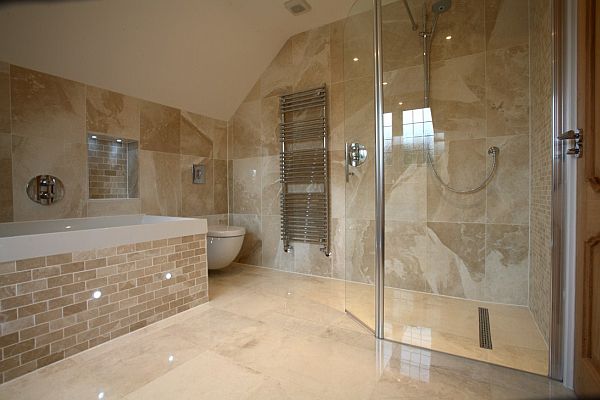The attractions of having a wet room as opposed to a conventional shower are becoming more and more apparent. They can offer a sleeker and often more practical alternative to the conventional shower and bathroom.
What is a Wet Room?
It’s basically a shower room that is fully open and tiled, and dispenses with the need for a shower screen and tray.
Practical Reasons
A wet room can liberate a small bathroom. Removing the bath and creating a wet room makes for more space, and the simplicity of a wet room means less cleaning as there’s no shower tray or screen.
They can also help in homes occupied by disabled people – it’s far easier to manoeuvre a wheelchair into a wet room than a conventional shower or bathroom.
Creating a Wet Room
You have to think carefully before undertaking the job yourself. Unless you have some industry-standard skills and experience certain aspects of the job should be left to professionals.
Which Floor?
It’s possible to build wet rooms on first and second floors along with ground floors, but it will depend on the structure of the property. If you’re not possessed of the required building knowledge, then an expert will be needed to at least advise on whether or not you can have a wet room in your chosen location.
Water Drainage
There must be a slight gradient leading to the grate where water drains away. How this is achieved may depend on the existing structure; sometimes a sub-floor made from WBP ply (a type of plywood) is used which is then tiled over.
Another method is to use a sloping shower former – a little like a large shower tray – which is also tiled over. The third method is using a large pre-formed tray that slopes towards the drain and fits across the whole floor with no need to tile over it.
Waterproofing
Waterproofing is the key to an effective wet room, and a job probably best left to experts. Waterproofing isn’t just using waterproof tiles and grouting to line the surfaces – it’s fully waterproofing the actual walls and particularly the floor.
If you’re undertaking the work yourself, it’s possible to buy diy wet room kits that contain everything needed for the installation, including ‘tanking’ (waterproofing) kits.
An expert will be able to tell if the walls and floor need attention.
Tiling
While tiles and grouting need to be waterproof, it should be remembered they can’t be relied on to actually make the wet room itself waterproof; there’s simply too much water too often for the grouting to stand up to it. Thorough waterproofing as discussed above is paramount.
Again, tiling may be best left to an expert but it’s likely to be the part of the process more within reach of the able DIY enthusiast. Wet room kit suppliers as mentioned above often offer a tiling kit option if desired.
Underfloor Heating
While not an essential for a wet room, underfloor heating is often recommended as it makes the space far more comfortable and can help remove moisture quicker.
Ventilation
This may already be taken care of if the room has been used as a bathroom or shower room previously, but making sure the space is adequately ventilated will also be important.
Making a Decision
Fitting a wet room yourself is possible and the various wet room kits and specifics such as waterproofing and tiling kits mean part or all of the task can be ‘pre-packaged’, but it’s vital to be honest about your experience and skills.
It’s possible to do some of the work yourself while leaving other aspects, such as the waterproofing, to more knowledgeable professionals.
Steven Lee runs Step-Free Wetrooms, an online retailer of wetrooms and wetroom accessories in the UK. Based in Essex, Steven covers the East of England, London and the rest of the UK.
